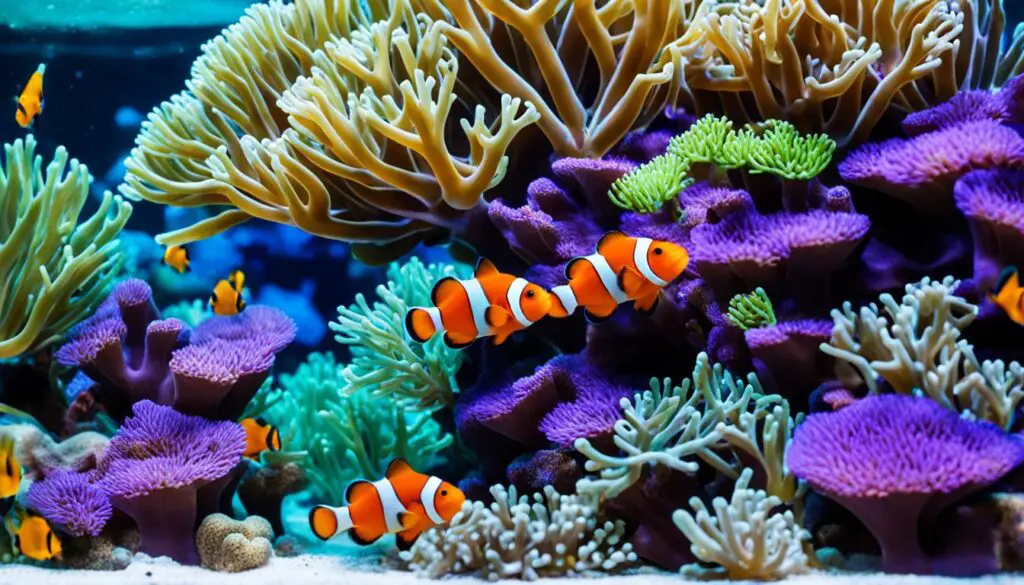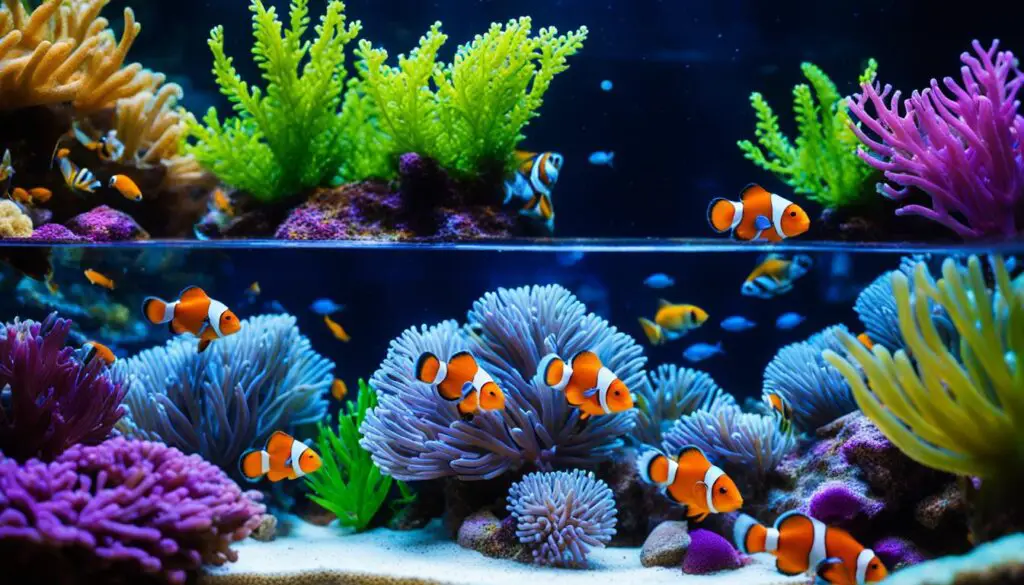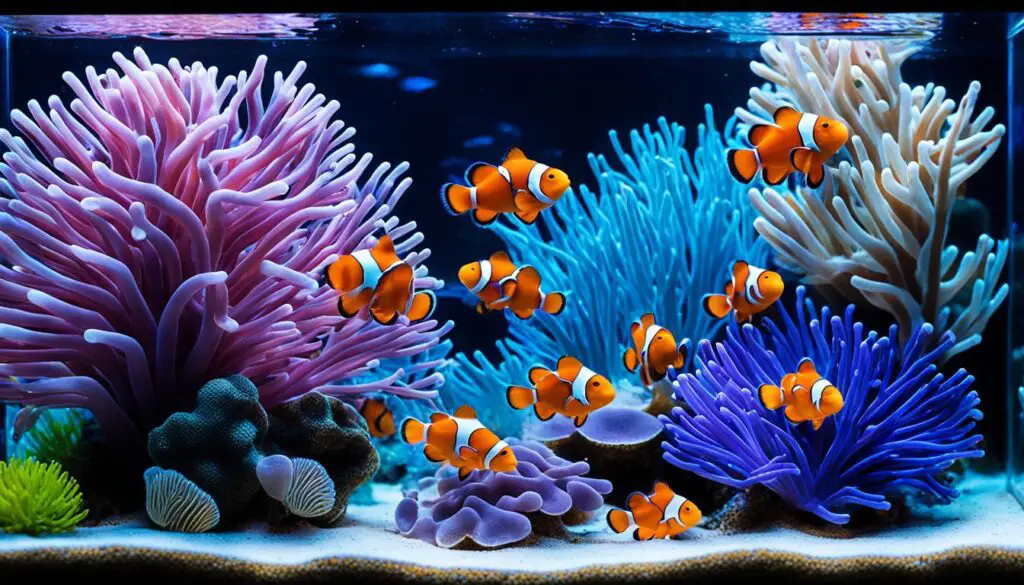Exploring the Diverse Types of Clownfish: A Visual Journey
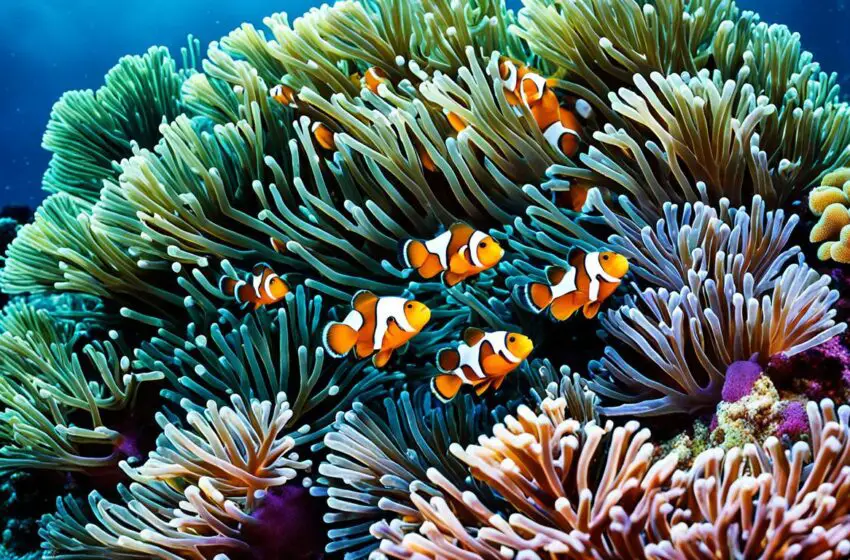
Clownfish, known from the Pixar movie Nemo, are smarter than you might think. A study from the Okinawa Institute of Science and Technology shows they have amazing skills. They show territorial behavior and can recognize different species by counting the stripes on them.
What’s interesting is they form a society with a clear pecking order. This shows they are not just simple fish swimming around. This study changes what we knew about clownfish and their world.
Key Takeaways:
- Clownfish exhibit cognitive abilities such as territorial behavior and species recognition.
- They can count the number of stripes on other clownfish to identify their species.
- Clownfish have a hierarchical social structure within their colonies.
- This research challenges the prevailing assumptions about clownfish intelligence.
- Understanding clownfish biology can contribute to their conservation and management.
*Please note that the image shown above is for illustrative purposes only and may not depict the exact diversity of clownfish species.*
The Cognitive Abilities of Clownfish: Counting and Recognition
Dr. Kina Hayashi and her team did a key study on clownfish. They found out that these fish can count and tell fish apart by their colors and patterns.
When clownfish saw others with the same three stripes, they got upset. This might be because they wanted to be the boss or to protect their home. Yet, they were peaceful with those having different stripes.
They use their sharp eyesight and clever mind to keep their space safe. By noting the stripes, they can also keep possible intruders away. This is important for their own safety and the safety of their home in the reefs.
“The ability of clownfish to count and recognize distinct patterns on their counterparts is truly remarkable. It demonstrates a level of cognitive sophistication and adaptability that was previously unknown in these colorful reef dwellers,” stated Dr. Hayashi during the announcement of the study’s findings.
Visual Recognition and Survival Strategies
Clownfish need their good eyesight to avoid fights. They can spot which fish looks like them to prevent quarrels. This helps keep them safe and make the reef a nicer place for all.
Knowing who is who helps them communicate better. This makes their groups stronger and more organized. As a result, they live in a balanced way with each other.

| Species | Number of Stripes |
|---|---|
| Ocellaris Clownfish | 3 |
| Percula Clownfish | 1 |
| Tomato Clownfish | 2 |
The table above shows how many stripes different clownfish types have. Clownfish are smart enough to notice these details. This helps them get along well with others in their groups.
The cognitive skills of clownfish show just how smart they are. Studying them helps us see the amazing life under the sea in a new light.
The Social Dynamics of Clownfish: Hierarchy and Colony Structure
Clownfish show interesting social life beyond their smart minds. Dr. Kina Hayashi and her team found out some cool things. They learned that a clownfish group has a top female, next a key male, and many younger fish that follow.
The big female runs the show. If someone grows too big, she kicks them out to keep things fair.
Dr. Hayashi’s team found a neat thing about the young ones that don’t breed. The biggest non-breeders protect the group from strangers. This means the boss isn’t always the same and depends on size and roles in making babies.
“The hierarchical structure of clownfish colonies plays a vital role in maintaining stability and survival within the colony,” says Dr. Hayashi.
The way clownfish groups are set up helps them work together and be safer. The order in the group makes sure they all get along well, use resources well, and defend against dangers.
Here is a look at how a clownfish group is organized:
| Rank | Position | Responsibilities |
|---|---|---|
| Alpha | Female | Dominant individual, leads the colony, protects territory |
| Beta | Male | Assists the alpha, helps defend the colony |
| Gamma | Juveniles | Non-breeding individuals, aid in colony defense |
This organized way of life helps clownfish be peaceful and strong in their reef homes.
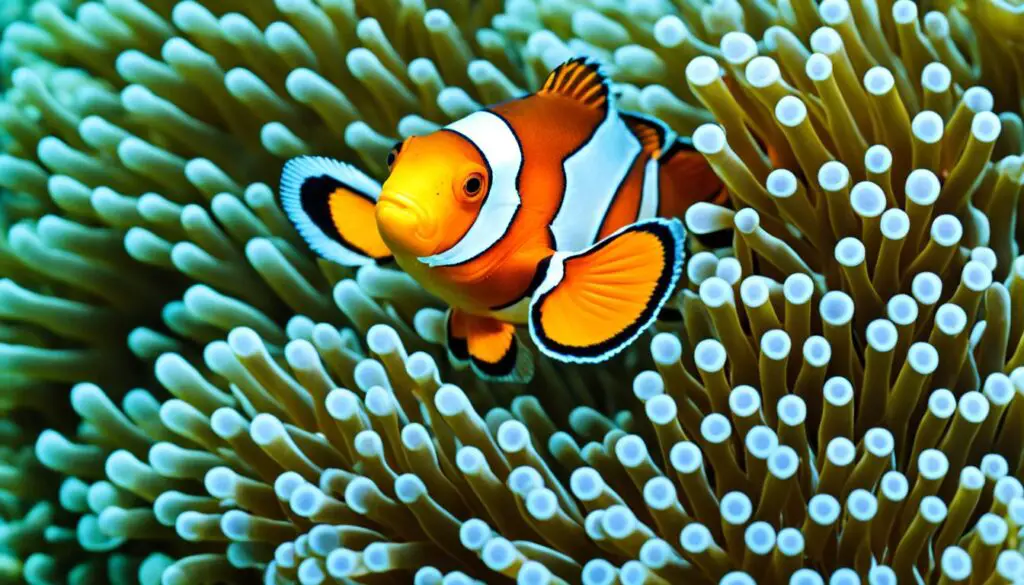
The Genomic Basis of Clownfish Adaptive Radiation
A study in Genome Biology and Evolution explores the genomic aspects of clownfish adaptive radiation. Researchers compared the genome sequences of these fish. They discovered how different species evolved so diversely.
Hybridization, mixing genes from different species, played a key part in this diversification. It created new genetic varieties. These helped the fish adapt to different environments.
The study also found genes that play a big role in the unique behavior and life of clownfish. These genes help with things like forming bonds, creating social order, and living with sea anemones.
This work deepens our understanding of how clownfish have become so diverse. It shows the complex link between their genes, adaptations, and success in nature. Knowing about clownfish genetic evolution is important for understanding their amazing variety and ability to flourish in various places.
Comparative Genomics of Clownfish Species
The study’s authors compared genomes from various clownfish types. This included the well-known wild orange clownfish and the saddleback clownfish. They looked at the genetic changes that allowed clownfish to adapt and evolve.
| Clownfish Species | Unique Genomic Features |
|---|---|
| Amphiprion percula | Enhanced visual perception for recognizing anemone hosts |
| Amphiprion polymnus | Genes associated with increased aggression for defending territories |
| Amphiprion clarkii | Genes involved in social hierarchy establishment within colonies |
The study identified how specific genes help clownfish adapt to different habitats. These genetic traits explain how clownfish have integrated into various environments. They give a detailed picture of the link between genes, traits, and homes of clownfish.
Studying the genomic foundation of clownfish adaptive radiation helps us better grasp this process. It’s crucial for conservation. This knowledge lets experts figure out what genetic factors help clownfish groups survive and grow in a changing world.
Conservation Implications for Clownfish Populations
Clownfish have evolved to live in complex environments. They interact closely with sea anemones and live in social groups. Studying their genetic makeup helps us learn how they survive. This knowledge is key to protecting them from environmental dangers.
Research into clownfish genetics provides clues for saving them. Scientists look at genes that help them live in their natural homes. This leads to actions that help keep these fish around, despite human impacts and changing climates.
To help clownfish, we need to protect their unique homes and consider their family structures. They rely on sea anemones for safety. So, keeping anemone areas healthy is vital for the fish. Knowing how they organize their groups also helps in their protection.
Understanding clownfish requires many fields to work together. Mixing genetics, ecology, and hands-on care is the best way to help them. This approach aims to secure these fish’s future and the health of their homes in the sea.
FAQ
Do clownfish have cognitive abilities?
A study by the Okinawa Institute of Science and Technology has shown that clownfish are quite smart. They look at the number of stripes on other clownfish to tell the species apart. This shows they can recognize different fish species really well.
What is the social structure of clownfish colonies?
In clownfish groups, there’s a clear order. At the top is the alpha female, followed by the beta male, and then several gamma juveniles. The largest of these juveniles becomes the alpha if the main one is gone. They take charge and guide the group.
What is the genomic basis of clownfish adaptive radiation?
A study in Genome Biology and Evolution says crossbreeding helped clownfish adapt and spread into new habitats. They also found specific genes that helped clownfish live and act in certain ways, making them well-suited to their environments.
Why is understanding clownfish genetic adaptations important for conservation efforts?
It’s key to saving clownfish because knowing about their genes helps make better plans for their protection. This research is vital for the long-lasting protection of these amazing sea creatures.

